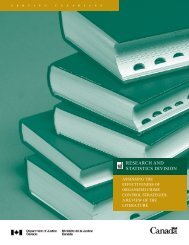National Threat Assessment 2008. Organised Crime - Politie
National Threat Assessment 2008. Organised Crime - Politie
National Threat Assessment 2008. Organised Crime - Politie
Create successful ePaper yourself
Turn your PDF publications into a flip-book with our unique Google optimized e-Paper software.
These are so-called ‘ABC transactions’ or sales carousels. 49 An investigation<br />
based on data from the Amsterdam Land Registry revealed that surprising price<br />
increases occurred for 351 buildings in the 2004 to 2005 period, which could<br />
indicate that criminal proceeds were being laundered. However, this is only a<br />
small part of the total number of transactions. For the four largest cities –<br />
Amsterdam, Rotterdam, The Hague and Utrecht – an analysis of the January<br />
2000 to March 2006 period showed that 1.3%, 4.5%, 3.5% and 1.6% of<br />
transactions, respectively, concerned owner-occupied houses that were sold<br />
three times or more. To what extent these were actually ABC transactions or<br />
sales carousels is unknown.<br />
3.6.4 Criminal organisation<br />
There is a difference between investments made by criminal organisations<br />
(as a group) and investments in property by individual members of these<br />
organisations. For the criminal organisations identified by IPOL the focus is<br />
on investments by the group. The same applies to the role of financial service<br />
providers: their role in money laundering for criminal organisations is of<br />
prime importance.<br />
Financial service providers are sometimes part of the criminal organisation,<br />
and they sometimes play a supporting role for several organisations. They are<br />
primarily called in for their expertise, and some of them have been working for<br />
the same organisations for years. These service providers often have normal jobs<br />
in the legal financial world. There were several occasions when criminals were<br />
maintaining strategic contacts in the legal financial world. There are examples<br />
of contacts with bank employees, tax and legal consultants and foreign bank<br />
managers. Criminal organisations seem to prefer small offices and lone traders,<br />
as they are economically more vulnerable and therefore easier to pressurise.<br />
But employees of major offices can also be contacted. Cases of threats against,<br />
violence against or even liquidations of financial service providers have<br />
been identified, but this does not appear to be common practice. Criminal<br />
organisations almost always use financial service providers from the same<br />
cultural background.<br />
49<br />
A building on Geldersekade in Amsterdam was a good example: the price of this small building<br />
went from € 108,000 (November 1995) to € 82,000 (August 1996), € 83,000 (January 1997),<br />
€ 166,000 (October 1999), € 295,000 (March 2000), € 700,000 (June 2005), and eventually to<br />
the € 1.3 million that the municipal organisation NV Stadsgoed paid on December 30th 2005.<br />
chapter 3 – Fraud and money laundering<br />
133








